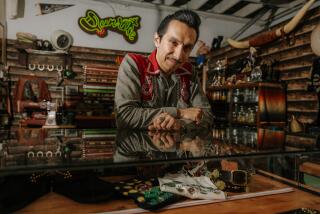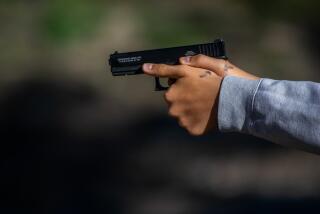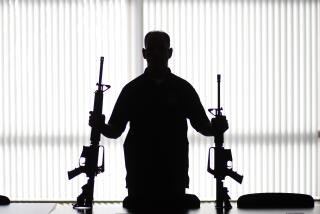Top Gunsmith Repairs the Best : Weapons: Dan Dwyer repairs rare and beautiful weapons, work that is beyond the skill of ordinary firearms experts.
SAN DIEGO — In olden times, when weapons were not so varied in style, a good gunsmith was a national treasure, a cherished craftsman-artist, importuned and honored.
Nicolas Noel Boutet--”Boutet of Versailles”--was such a man. Henry Hadley of England was another. So was Michele Lorenzoni of Florence. There were others.
A man such as these, a creator who could design a gun and make it and maybe decorate it too, was singular, distinguished.
Dan Dwyer of Mission Hills is such a man. Of course, weapons are more numerous and varied now, and the world has become so crowded that his fame does not spread across the entire land.
He may be unknown nationally, but in San Diego County, Dwyer is the man to see about repairing a rare and beautiful weapon, work that is beyond the skill of ordinary gunsmiths.
Around San Diego County, when someone has a problem an ordinary gunsmith cannot handle, or if someone owns a rare and beautiful weapon that, for repair, should be entrusted only to a sine qua non , the call is usually for Dwyer.
Whatever it is, they say, Dwyer can do it.
“I had a 200-year-old, double-barrel flintlock English pistol, willed to me by an ancestor,” a customer said recently at Dwyer’s shop. The customer, who asked not to be identified so burglars would not try to liberate his weapons collection, wanted the old pistol in working order, even though he would fire it only a few times for sport and then display it in a case.
“Dan had to remove the barrel, had to unscrew it, to plane it. He had to make a wrench, with hand threads, like the barrel had, in order to do this,” the customer said. Dwyer also had to make several parts for the antique weapon. He did everything necessary. And the gun worked perfectly.
“I’ll never forget that,” the customer said. Then he said it again, awed, and added, “The average gunsmith wouldn’t have known what to do.”
The customer had stopped by with another museum piece, this one made in Scandinavia with one long rifle barrel and two shotgun barrels. It was about 200 years old, was not working properly, and he wanted it restored. Dwyer would know what to do.
“He’s the last of the masters,” longtime friend and customer Bert Wright said. “He’s a true artisan.”
Wright, who was on the San Diego Police Department Revolver Club from 1952 until retiring from the force in 1981, and who was team captain and coach for much of that time, competed with pistols Dwyer made.
“He made special barrels and put them on .38 (caliber) Smith & Wesson frames,” Wright said. “There’s a recoil factor you want to lessen.” (Dwyer obviously lessened it, because Wright is known as a crack shot.) “Dan’s a master machinist. What he can do with a lathe. . . . I used to just stand around in his shop and watch him work.”
And this from Bruce Cavanaugh, a co-owner of long-established Krasne’s Gun Shop, downtown:
“I’ve never known any work of his to go wrong. He takes his time. He’s very, very, very careful of his reputation. He’s selective concerning what he’ll take on, the gun and the person. His reputation is much larger than his list of customers because of his selectivity.”
Dwyer, 83, is the senior gunsmith in the county. His shop, Sportsmen’s Equipment Co. at 915 W. Washington St., is a large and dusty machine-filled room that has been his headquarters since 1964. Before that he worked nearby in Hillcrest, where he also sold guns and fishing tackle.
It was in Hillcrest in about 1952 that Dwyer repaired what he said was the most expensive gun he has worked on, a two-barrel English-made Purdey shotgun “valued then at $15,000 to $18,000, today $27,000 to $30,000.” The oldest he has worked on were flintlocks from the period of the American Revolution and German matchlocks from the 1600s, weapons so primitive that they were fired by the user holding a slow-burning match to the powder in the breech.
In a 1955-1964 hiatus from gunsmithing, Dwyer was on the federal payroll as an engineer working on missiles. That, too, is part of his story: Despite his reputation as the longest-established and probably best gunsmith in San Diego County, Dwyer has never called gunsmithing his main toil.
“Gunsmithing has always been an avocation with me,” he said. “My life has been almost entirely with the armed services. For the last 25 years, gunsmithing has been play, mostly, or I wouldn’t have done it, because it’s not the best-paying.”
But he was “born to it,” he said, possessing an adventuresome mind and an inordinate skill with tools. A good gunsmith, he said, must be in tune with the shooters.
“It’s a combination of experimenting with the different things that come up and a great deal of ability to mechanically contrive--and some degree of artistry. The woods are literally full of gunsmiths, and a hell of a lot more that profess to be and some that really are.
“Some only install recoil pads (on butts of rifles and shotguns) and telescopes. Then there is the venture type, of which I’m one. First you have to be a machinist. You have to have a certain degree of resourcefulness, patience.”
His shop contains lathes and drills, saws and mills, plus myriad hand tools. He has used them with love and care and perhaps even genius to produce parts that are no longer manufactured, or just to duplicate a part that could be ordered but which the customer did not want to wait for.
Dwyer has made innumerable trigger springs, of course, plus all the other parts that break less frequently; made those hybrid guns for Bert Wright; refined a few .45-caliber semiautomatic pistols for nationally known marksman Lee Echols and built several of what he calls “cross-eyed stocks” for the late San Diego contractor Roscoe (Pappy) Hazard, who, because of a vision problem, had to sight with the opposite eye.
And he built a cannon.
It was for General Dynamics, which could have afforded a large one, but needed only a table model.
“It looked like the famous cannon that was designed for Ft. Sumpter. Big breech, small barrel,” Dwyer said.
The gun, which had a 12-inch barrel and a bore of only 1 inch, was designed to shatter plastic into bits and propel the pieces against the Atlas missile skin to test its resistance to small particles of the type that might be encountered in space.
“It achieved a muzzle velocity way in excess of 10,000 feet per second,” Dwyer said.
He also placed his specially made barrels, magazines and other apparatus on .45-caliber Colt semiautomatic pistols, again for target shooting, and he has made numerous derringers “from scratch.” He even made cap-and-ball pistols and won matches with them.
“Lots of people do that,” he said.
He is prouder of his marksmanship in more serious shooting as a member of winning teams at the military bases he worked for, and later with the Convair Pistol Club and Solar Gun Club, for which he fired handguns.
Dwyer invented, and for many years sold, two types of interior modifiers for pistols. He called them “accurizers,” because they improved accuracy. The most successful was a two-piece adaptation for .45-caliber semiautomatics. He patented it as the Group Gripper and sold it for 15 years.
“It reduces the size of the groups of shots fired into a target,” Dwyer said. A few years ago, he sold the patent to Billy Wilson of Berryville, Ark. Shooters across the land who do not know Dwyer personally are nonetheless well-acquainted with his accurizers.
His career, which he considers a hodgepodge, began in Dayton, Ohio, where he was born July 31, 1906. His father, James Francis Dwyer, was a shoe salesman traveling out of St. Louis. His mother was the daughter of a Union Army cavalry captain during the Civil War. In 1926, Dan Dwyer married Mary Catherine Wirtz. They would have two sons and two daughters.
Like many boys and other young men on the west side of Dayton, Dwyer knew aviation pioneer Orville Wright.
“Orville was available to all the kids in my neighborhood,” Dwyer said. “He was our judge in model airplane contests. I used to go to his shop office and argue with him.”
Those discussions often involved flight.
“I never knew Wilbur (who died of ptomaine poisoning in 1912), but I saw the toy helicopter their father brought home that got them interested in flight.”
By 1930, Dwyer was manufacturing toy airplanes.
In 18 months, he said, he and his partner had a cash surplus of $140,000. They invested the money on a paving-and-curb project of a residential development.
“The developer went broke and so did we.”
He started a new career in 1932.
“I was a gunsmith in a pawn shop part time. I had got the job by hanging around in off time. A police sergeant decided we should be in the gun business. . . . I had assimilated sufficient knowledge about guns and farm equipment to get along.
“I was born into it. The neighborhood where I was raised as a boy was full of gunsmiths. Canal Street, Dayton. Also locksmiths. They made gun barrels. The so-called gunsmith made stocks, and the barrels and stocks were sent to Tennessee and Kentucky,” where the final product was made.
“I sort of hung around and was absorbed. There were so many of them you just couldn’t help being interested,” he said.
So by 1932, he and the policeman friend, Oliver Kinkaid, had opened the Vandalia Arms Co. at Dayton Municipal Airport, next door to the home practice grounds of the national trapshooting school. Before long, however, the government was again calling on this man who had learned his engineering from correspondence schools, on the job and at a UCLA symposium.
In the next few years, he ran the bombsight department for the Army Signal Corps at McClelland Field in Sacramento; ran the radio shop fo the Signal Corps at North Island in 1936 when it was still the Army’s Rockwell Field; was, during World War II, assistant superintendent of shops for the Air Corps at March Field, working in radio, ordnance and bombsights, and was coordinator of bombsight training and maintenance of Norden bombsights at Norton Air Force Base.
With war’s end, he set up shop in Hillcrest, then put in that 11-year stint with General Dynamics, working at various tasks concerning the Atlas weapons systems and space boosters in a variety of cities, including San Diego.


